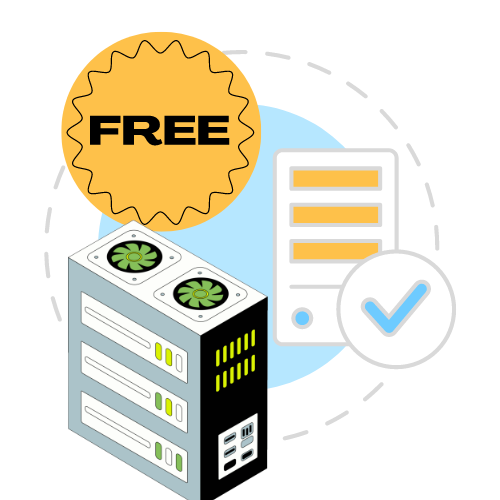VPS
VPS, for less.
with more resources for less.
Simple,
Affordable,
High-performance.
Create your servers in seconds, with your favorite OS, at your favorite location.
Control, manage and monitor with ease, using Mavihost cloud platform.
Enjoy 24/7 FREE support!

Create in seconds
Create your servers in seconds using our self-service platform.
Backup / Restore with a click
Create backups and restore them on the same or a new VM with a few clicks.
High-end hardware
Our cloud infrastructure are powered by latest high-end hardwares and technolgies.
Pre-built OS images
Ubuntu, Rocky, Windows, and more! Create your next VM with your favorite OS in seconds.
Pre-built software images
Launch a VM with cPanel, DirectAdmin or your favorite software using our pre-built images.
Your custom images
Upload your custom images or use your backup images. Create next servers using your own images.
6 locations, worldwide.

Get Your FREE VPS Server for a Day
- WINDOWS
- UBUNTU
- Debian / AlmaLinux

VPS Pricing Plans
deLinuxVPS1
145 TL (Aylık)
- RAM: 1024 MB
- SSD: 50 GB
- CPU: 1 Core
deLinuxVPS2
175 TL (Aylık)
- RAM: 2 GB
- SSD: 100 GB
- CPU: 1 Core
deLinuxVPS3
203 TL (Aylık)
- RAM: 3 GB
- SSD: 100 GB
- CPU: 2 Core
deLinuxVPS4
225 TL (Aylık)
- RAM: 4 GB
- SSD: 100 GB
- CPU: 2 Core
deLinuxVPS5
348 TL (Aylık)
- RAM: 6 GB
- SSD: 100 GB
- CPU: 4 Core
deLinuxVPS6
415 TL (Aylık)
- RAM: 8 GB
- SSD: 100 GB
- CPU: 6 Core
ukLinuxVPS1
145 TL (Aylık)
- RAM: 1024 MB
- SSD: 50 GB
- CPU: 1 Core
ukLinuxVPS2
175 TL (Aylık)
- RAM: 2 GB
- SSD: 100 GB
- CPU: 1 Core
ukLinuxVPS3
203 TL (Aylık)
- RAM: 3 GB
- SSD: 100 GB
- CPU: 2 Core
ukLinuxVPS4
225 TL (Aylık)
- RAM: 4 GB
- SSD: 100 GB
- CPU: 2 Core
ukLinuxVPS5
348 TL (Aylık)
- RAM: 6 GB
- SSD: 100 GB
- CPU: 4 Core
ukLinuxVPS6
415 TL (Aylık)
- RAM: 8 GB
- SSD: 100 GB
- CPU: 6 Core
caLinuxVPS1
175 TL (Aylık)
- RAM: 1024 MB
- SSD: 50 GB
- CPU: 1 Core
caLinuxVPS2
210 TL (Aylık)
- RAM: 2 GB
- SSD: 100 GB
- CPU: 1 Core
caLinuxVPS3
243 TL (Aylık)
- RAM: 3 GB
- SSD: 100 GB
- CPU: 2 Core
caLinuxVPS4
270 TL (Aylık)
- RAM: 4 GB
- SSD: 100 GB
- CPU: 2 Core
caLinuxVPS5
418 TL (Aylık)
- RAM: 6 GB
- SSD: 100 GB
- CPU: 4 Core
caLinuxVPS6
498 TL (Aylık)
- RAM: 8 GB
- SSD: 100 GB
- CPU: 6 Core
trLinuxVPS1
175 TL (Aylık)
- RAM: 1024 MB
- SSD: 50 GB
- CPU: 1 Core
trLinuxVPS2
210 TL (Aylık)
- RAM: 2 GB
- SSD: 100 GB
- CPU: 1 Core
trLinuxVPS3
243 TL (Aylık)
- RAM: 3 GB
- SSD: 100 GB
- CPU: 2 Core
trLinuxVPS4
270 TL (Aylık)
- RAM: 4 GB
- SSD: 100 GB
- CPU: 2 Core
trLinuxVPS5
418 TL (Aylık)
- RAM: 6 GB
- SSD: 100 GB
- CPU: 4 Core
trLinuxVPS6
498 TL (Aylık)
- RAM: 8 GB
- SSD: 100 GB
- CPU: 6 Core
frLinuxVPS1
145 TL (Aylık)
- RAM: 1024 MB
- SSD: 50 GB
- CPU: 1 Core
frLinuxVPS2
175 TL (Aylık)
- RAM: 2 GB
- SSD: 100 GB
- CPU: 1 Core
frLinuxVPS3
203 TL (Aylık)
- RAM: 3 GB
- SSD: 100 GB
- CPU: 2 Core
frLinuxVPS4
225 TL (Aylık)
- RAM: 4 GB
- SSD: 100 GB
- CPU: 2 Core
frLinuxVPS5
348 TL (Aylık)
- RAM: 6 GB
- SSD: 100 GB
- CPU: 4 Core
frLinuxVPS6
415 TL (Aylık)
- RAM: 8 GB
- SSD: 100 GB
- CPU: 6 Core
Launch your next cloud servers in seconds, using our pre-built images
- UBUNTU
- WINDOWS
- CENT-OS
- YOUR CUSTOM IMAGES
- Total requrests resolved +16.45%
4,3 Million
Supporting +103,000 customers, 24/7!
Try our unbeatable FREE support.
- Free Troubleshooting
- Free configuration
- Free Setup
Frequently Asked Questions
When a computing resource is said to be “in the cloud,” it means that it is delivered over a network like the Internet, as opposed to being located on-premises and accessed directly. A cloud server is one of the most prominent examples of a cloud computing resource, along with cloud storage, databases, networking and software.
“The cloud” has come to be synonymous with the Internet in general. But there are actually many clouds, both public and private, which are formed by any set of connected servers that deliver computing resources over a network.
A cloud server can be contrasted with a traditional, dedicated server. While a cloud server’s resources can be shared by many users, a dedicated server is designed for exclusive use by one company. It must be set up and managed by that organization, while a cloud server can be owned and managed by a third party.
Companies large and small have multiple options when it comes to choosing the right cloud server option. The best cloud servers are optimized for specific needs and budgets. What works for a global enterprise might not be right for a mid-market company.
Cloud servers can be deployed in three primary types of clouds:
Public cloud: Cloud servers are most commonly deployed via the public cloud. In this scenario, a third-party provider owns and manages the servers and other infrastructure, and gives its customers access to on-demand computing services.
Private cloud: A company can host its own cloud servers privately and maintain control of their management and maintenance. These server resources are not shared with other organizations, but since they are in the cloud, they can be accessed remotely by any employee, typically through a company intranet or VPN.
Hybrid cloud: Public and private clouds can be combined with on-premises cloud servers and off-site cloud servers working together. This hybrid cloud environment gives companies more options and flexibility to maintain control and security when necessary. It also leverages public clouds when they must quickly expand to meet surges in demand.
Cloud servers have revolutionized the IT industry. Countless companies have moved away from traditional, centralized server and infrastructure setups to take advantage of this game-changing technology. Four primary benefits drive this shift:
- Affordability: Using cloud servers managed by third-party providers is far less expensive for a company than purchasing and maintaining their own infrastructure. Companies benefit from economies of scale when sharing server resources with others, and they pay only for the resources they use.
- Convenience: Public cloud resources can often be provisioned in a matter of minutes, and easily managed through a single control panel or API. When IT teams no longer need to maintain complex infrastructures on-premises, their resources are freed up for other tasks. Users can access data from anywhere.
- Scalability: As computing and data storage needs change, cloud servers can respond quickly, scaling up or down to meet demand.
- Reliability: Cloud servers can deliver the same performance as dedicated servers. Since the cloud runs on multiple servers in a shared environment, service can continue even if a single component fails.
One of the challenges is having less control, since a company using a public cloud does not manage its own infrastructure in-house. If a public cloud experiences an outage or slows down due to unexpected demand from other customers, they must wait for the provider to fix the issue.
That’s why some companies choose to deploy a mix of cloud and on-premises infrastructure. The latter can be dedicated to mission-critical or high-security workloads, keeping them under their own control.
